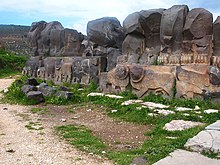Ain Dara (archaeological site)
Ain Dara may have been devoted to Inanna, the female Mesopotamian deity of fertility and civilisation,[6] or to the Canaanite version of Ishtar, ʿAṯtart.
[7] It also might have been dedicated to the male storm deity Hadad, or it might have been an oracle on a road known as the international coastal highway between the Syrian Desert and Mediterranean Sea.
[14] The entrance porch, or portico, marked by two basalt piers or pillars, and a wide hall, were not roofed over and were part of an open courtyard.
[4] Paved floors and wall reliefs are visible in the multistoried hallways, at least three stories high, that flank three sides of the temple,[3] with at least one southern entrance.
The layout of Dara is similar to that of the Biblical temple, which was also of a long room plan with the three-room configuration of a portico at the entrance followed by the main chamber with the shrine.
Other similarities include In brief, 33 of the architectural elements found in Ain Dara are tallied with 65 of the features mentioned in the Biblical description of Solomon's Temple.
[16][17] Aerial bombardments of the Ain Dara site were first reported by a local resident via Dutch news network NOS on 23 January 2018.
As stated by the Directorate of Antiquities in Afrin on 31 January 2018: "Turkish forces revealed the occupation of Syrian geography in its real face, especially the Turkish state, since the declaration of war on Afrin canton on 20 January 2018, as it escalated Operation Olive Branch to go beyond the targeting of military forces to include shelling villages and towns full of civilians from the elderly, children and women To the rich and varied history and civilization of the province from prehistoric times to the present day."
"On 27 January 2018, the Turkish state warplanes bombarded and damaged the ancient "Ein -Darat" temple, despite its distance from the fighting fronts and the areas of engagement, by about 20 kilometers.
We call on the international community and all organizations involved in this field to intervene immediately, seriously and Turkish Cultural and Human Heritage in Afrin canton".
[21] In early December 2019, Al-Hamzat backed by Turkish forces, took part in Operation Peace Spring, journeying out to eventually plunder the already Turkish-bombed disaster area of 'Ain Dara's archaeological site.
The basalt lion sculpture, which was discovered in 1956, like the Ain Dara temple itself, is now gone:"On December 20th [2019], the Turkish army and its mercenaries attacked Afrin with tanks, artillery and jets causing massive destruction of the city....Recent footage of a military exercise by a pro-Turkish militia (National Liberation Front) who established a shooting range against the archaeological hill of Ain Dara in the occupied Afrin province invaded and controlled by Turkish forces and their proxy militias last year, revealed the tragic disappearance of the famous historical masterpiece known as The Lion of Afrin.
organizations and human rights groups have heavily warned since February 2019 that Turkish backed rebel forces were carrying out systematic violent and deadly attacks against Kurdish civilians in Afrin.
[23] “The commission finds there are reasonable grounds to believe that armed group members in Afrin committed the war crimes of hostage-taking, cruel treatment, torture, and pillage,” the United Nations report said.
[26] Qamishli is situated at the base of the Taurus Mountains, located near the area of ancient Hurrian city of Urkesh, which was founded during the 3000 BC era.
Excavations have been on hold during the Syrian War since 2011, but unlike Ain Dara, the Urkesh site is protected by Kurdish YPG troops since 2016.
Additionally, in the town of Urkesh, the copper Louvre lion and accompanying stone tablet bearing the earliest known text in Hurrian was discovered, dating to the Akkadian period of 2300 – 2159 BC.





